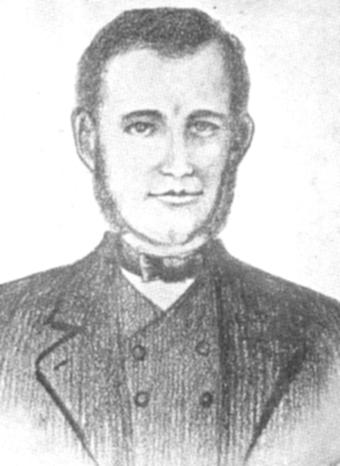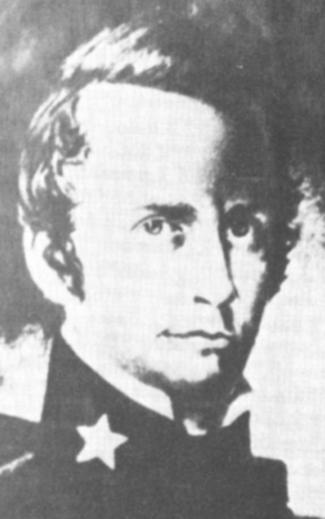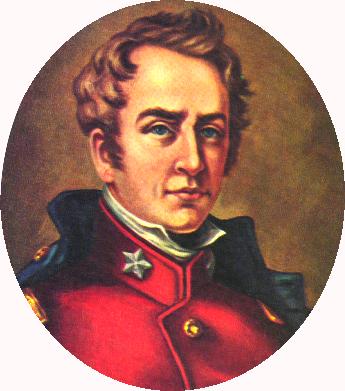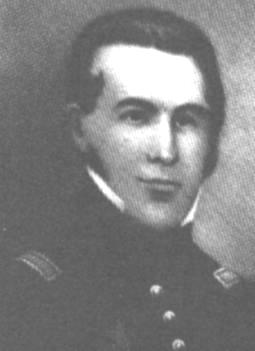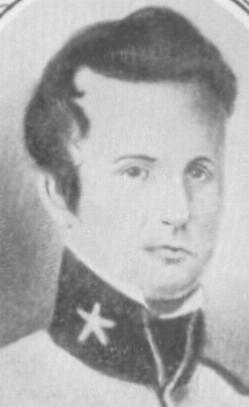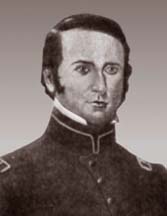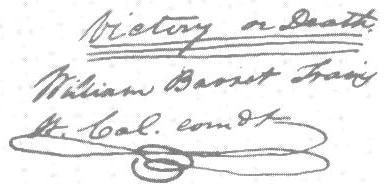SONS OF DEWITT COLONY TEXAS The DeWitt Colony Alamo Defenders
For Biographies, Search Handbook of Texas Online Appeal to DeWitt Colonists. About 4 PM on 23 Feb 1836, Launcelot Smithers left the Alamo and made the 76 mile ride to Gonzales where he announced the arrival of the Mexican army in San Antonio de Bexar with a note from Alamo Commander, Col. William B. Travis, to alcalde Andrew Ponton appealing for reinforcements:
On the same day of arrival of the message, Acting Commissioner and Aide-de-Camp to the Provisional President of the Republic of Texas Byrd Lockhart completed the muster of 23 into the Gonzales Ranging Company of Mounted Volunteers which he had been commissioned to do in Gonzales on 4 Feb. The Gonzales Rangers were officially attached to Col. Travis' command within the provisional Republican Army. The official muster roll in the Texas Archives below was completed on 23 Feb, however most individuals who joined the Gonzales Alamo Relief Force on 24 Feb and thereafter are often listed as members of the company even though no official muster roll is available.
On 24 Feb courier Launcelot Smithers wrote from Gonzales:
On 24 Feb, the passionate and alarming appeal of Colonel Travis in his own handwriting to all people of Texas and all Americans was carried to Gonzales by Captain Albert Martin who first delivered it upon his arrival on the 25th to Smithers who carried it on to San Felipe on the 27th. It is believed that Smither may have left the original copy with alcalde Ponton while moving on to other sites with extracts or copies. Ponton distributed copies or the essence of the letter to other muncipalities in Texas where broadsides and flyers were made for distribution as well as printing in the newspapers The Texas Republican and Telegraph and Register on 2 Mar and 5 Mar, respectively.
On the back of the letter, Capt. Martin penciled in
An additional note by Smithers was handwritten sideways to the above
According to Dr. John Sutherland in his personal memoirs, The Fall of the Alamo, he also left the Alamo under order from Travis between 3 and 4 PM on 23 Feb and arrived in Gonzales at 4 PM on Wednesday 24 Feb with courier John W. Smith. Gonzales Rangers Respond. Two appeals to Col. Fannin at Goliad had resulted in an aborted start toward San Antonio with his force of 350 men when Fannin heard of the approach of Gen. Urrea's army. Responding to Col. Travis' appeals, the main contingent of the Gonzales Alamo Relief Force departed the town square of Gonzales at 2 PM Saturday 27 Feb, led by commanding officer Lieutenant George C. Kimble of the Gonzales Rangers. The senior officer accompanying the relief force was courier Capt. Albert Martin who had delivered the appeal to both Smithers and Gonzales. The force was guided by Alamo courier John W. Smith, a resident of San Antonio de Bexar. According to Dr. John Sutherland, the group consisted of 25 men who left Gonzales and increased to 32 with those who joined along the way, in particular near Cibola Creek. On 29 Feb, the group prepared to find a way into the Alamo through the surrounding Mexican forces. Dr. John Sutherland relates the story that
After being shot at by Alamo sentries, the gates swung open and the Gonzales force made their dash into the fort at 3 AM, Tuesday 1 Mar 1836. The Gonzales Alamo Relief Force consisting of primarily the men of the DeWitt Colony listed here was the only organized force in Texas which effectively responded without question to the appeals of Travis to aid their doomed colleagues in the mission. Some were single men, but most were husbands and fathers of large families. Concern for families short and long term safety, loyalty to the Constitution of 1824 as Mexican citizens, the hatred precipitated by their betrayal by the centralista dictatorship of Santa Anna, the committment to Texas Independence and suspicion that the Alamo might be a lost cause in the larger war of independence caused great personal conflict in making the choice to join the Relief Force. Fathers and sons, some in their teens, argued over who should go and who should remain with family (see King and Kent). Patriotic mothers and impending widows, some pregnant (Kimble) and one blind mother of multiple small children (Millsap), agonized, but consented and encouraged husbands to go to the aid of their neighbors. Of the 23 DeWitt Colonists who were mustered into the Gonzales Ranging Company of Mounted Volunteers on 23 Feb, 12 are believed to have entered the Alamo with the Gonzales Alamo Relief Force and all but one of the 12 died there. It is currently believed that at least 32 of the Alamo casualties entered the Alamo on 1 Mar 1836 in the relief force of which 27 and possibly 31 are believed to have been DeWitt Colony residents. David Cummings, a surveyor, joined the group near the Cibola as they approached Bexar. It is possible that individuals now included in the relief force were already in the garrison at the time of arrival of Santa Anna's forces and that others listed as in the garrison arrived with the force. It is possible that other individuals, currently unknown, joined the group along the way. Of the 27 members of the Gonzales Alamo Relief Force who can be clearly verified as DeWitt Colony residents, the oldest was Andrew Kent at age 44, 4 were over 40, 5 aged 31-40, 14 aged 21-30 and four (Fuqua, Gaston, Kellogg and King) were teenagers, the youngest of which was 16. San Antonio historian Charles Merritt Barnes related that
the latter referring to when the bodies of the defenders and Mexican Army casualties were being separated for disposal. Records show at least seventeen had been engaged in prior military engagements in service of Texas, primarily in the Battles of Gonzales, Concepcion and Bexar. At least 22 were homestead and property owners (or members of families who were) of record in the colony. Three were civil servants of record (Kent, Miller, Millsaps), most were farmers and ranchers, two (Kimble and Miller) were merchants and two (Almeron Dickinson and Jacob Darst) were skilled blacksmiths with shops in Gonzales. Seven within the group were related to at least one other member and several had multiple relations in the group. At least ten more DeWitt Colony residents were defenders of the Alamo and died there. Several more were couriers not present in the final moments of battle. By any estimate, participation of the DeWitt Colonists in the Battle of Gonzales and the Battles to remove the centralistas from San Antonio de Bexar, the ancient capital of Texas, culminating with the Battle of the Alamo was larger per resident than any other single municipality or district of Texas. Members of families of the Municipality of Gonzales, who comprised only about 4% of the total population of Texas, accounted for 20% of the casualties at the Alamo. Put another way, over 4% of the total population of the DeWitt Colony, among them some of their most productive landholders, ranchers and farmers as well as merchants and civic leaders, died in the Alamo while total Alamo casualties represented less than 0.5% of the total population of Texas. Alamo
Defenders-Index |
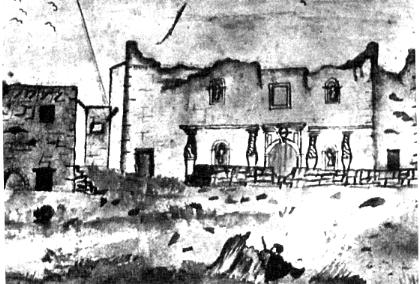 At dawn on the first of March [1836], Capt. Albert Martin,
with 32 men (himself included) from Gonzales and DeWitt's Colony, passed the lines of
Santa Anna and entered the walls of the Alamo, never more to leave them. These men,
chiefly husbands and fathers, owning their own homes, voluntarily organized and passed
through the lines of an enemy four to six thousand strong, to join 150 of their countrymen
and neighbors, in a fortress doomed to destruction. Does American history, or any history,
ancient or modern, furnish a parallel to such heroism? ......They willingly entered the
beleaguered walls of the Alamo, to swell the little band under Travis, resolved
"never to surrender or retreat." In after many years it was my privilege to
personally know and live near many of their widows and little ones and to see the latter
grow into sterling manhood and pure womanhood. I never met or passed one without
involuntarily asking upon him or her the blessings of that God who gave the final victory
to Texas--John Henry Brown in History of Texas.
At dawn on the first of March [1836], Capt. Albert Martin,
with 32 men (himself included) from Gonzales and DeWitt's Colony, passed the lines of
Santa Anna and entered the walls of the Alamo, never more to leave them. These men,
chiefly husbands and fathers, owning their own homes, voluntarily organized and passed
through the lines of an enemy four to six thousand strong, to join 150 of their countrymen
and neighbors, in a fortress doomed to destruction. Does American history, or any history,
ancient or modern, furnish a parallel to such heroism? ......They willingly entered the
beleaguered walls of the Alamo, to swell the little band under Travis, resolved
"never to surrender or retreat." In after many years it was my privilege to
personally know and live near many of their widows and little ones and to see the latter
grow into sterling manhood and pure womanhood. I never met or passed one without
involuntarily asking upon him or her the blessings of that God who gave the final victory
to Texas--John Henry Brown in History of Texas.